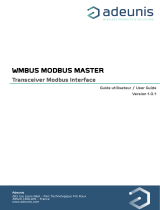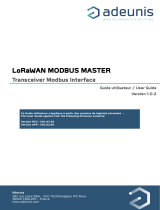Page is loading ...

Notice technique complète sur www.atim.com
FRQIG_ARM-IOD-LP
Page1/4
Before using the product, read carefully the following recommendations:
✔ Do not power supply the radio modem with 110 or 120V (recommended voltage: 10 to 30Vdc).
✔ For your safety, the power supply connection to the radio modem must be realized off voltage. Check that the
module power supply is off before all operations.
✔ Do not use without antenna!
Modem
Type
Mode
Address
Radio channel
Modbus Mirror
Modbus Mirror
Modbus Mirror
Modbus Mirror

Notice technique complète sur www.atim.com
FRQIG_ARM-IOD-LP
Page2/4
2
1
4
3
✔ If the antenna is fixed outside on a pole, it must be link to the ground. A surge protector must be installed between
the antenna and the ARM radio modem.
✔ Respect the norms, using recommended antenna cables to stay in the authorized emission limits (according to the
channel: 5mW, 25mW or 500mW).
1. DESCRIPTION
M12 connector pin out :
N°
Connection
Input/output type
Designation
1
GND
Masse
2
INP2
Input
Logic input 2
3
INP1
Input
Logic input 1
4
GND
Masse
2. INSTALLATION
2.1. Antenna
The ARM-IO is delivered with a small ¼ wave antenna. If you want better performance, you can use one of these antennas:
✔ ANT868-12FSC (Antenna ½ wave): this antenna can be directly mounting on the l'ARM-IO.
✔ ANT868-12S-L (Antenna ½ wave): no needs to metallic planfloor, it can be mounting directly on a polyester support of a
vehicle or above a PVC case.
For best results, we recommend to install the two antennas in line of sight and as high as possible.
2.2. Communication modes
The mirror mode allowed the report of contacts or
analogical values to a distant radio module, which can be
an ARM-D or an ARM-X. Then the radio module can
centralize the values from several distant ARM-IOD-LP.
L’ARM-IOD-works in 3 modes:
- Mirror mode
- Modbus slave
- Sensor mode(datalogging)
See the use manual for functioning
choice
In modbus slave mode, all
configuration registers and
following functions are available:
- Reading logic input
- Reading/writing memorized input
- Reading voltage power supply
- Reading RSSI value
- Reading/writing rising edge and
falling edge (see use manual)

Notice technique complète sur www.atim.com
FRQIG_ARM-IOD-LP
Page3/4
The modbus mode is frequently used with a master
modbus automaton or with a supervisor connected to an
ARM-IOS or an ARM-SE.
The sensor mode works with master ARM-SE radio
modem, which can repatriate automatically and cyclically
the information (datalogging). Data are then searchable
in mdbus.
Vous pouvez utiliser les ARM-IO avec les autres modems
de la gamme ARM : ARM-SE, ARM-D, ARM-DA, ARM-X,
etc.
2.3. Frequency table
Channel
Frequency (MHz)
Default powerful
Duty cycle
Range
1
868,075
25mW
1%
<1km
3
868,175
5
868,275
7
868,375
9
868,475
D (13)
869,475
25mW
10%
<1km
F (15)
869,575
3. Technical characteristics
ARM-IOD-LP
Characteristics
Interface
2 digital inputs
Logical input
Negative logical
Max frequency counting: 100Hz
Delay
“Wake-up” delay : 1,55
Answer delay : 3,55
Operating modes
Modes : mirror, Modbus, sensor
Configuration
Automatic
Power supply
3,6V battery withdrawable
Max consumption
25mA (Rx) – 60mA to 25mW (Tx) – 15µA in sleep mode
Frequency radio
868,000 à 869,900MHz – Puissance max 25mW
Radio
Modulation FSK – Debit : 9600
Range
As far as 1km en outdoor
Connection
6 points bloc connector (screw thread : 2,54mm)
Box
ABS (IP65) : 65x60x40mm (without antenna)
Functioning/storage
temperature
-20°C to +55°C / -40°C to +70°C
Conformity
ETS300-220-3 v1.1.1 / EN 301 489-3 v1.4.1
4. CONFIGURATION IN MODBUS MODE
The modem configuration can be made in the manufactory.
For erasing the modem configuration:
– Disconnect the battery
– Run down the remaining voltage in shorting circuit the + and the - of the battery connector
ARM-IO are provided with a
performing sleep mode (configuration
only with modbus commands. See the
use manual).
In mirror mode, the radio frame is
secured with addressing (last octet
of the serial number) and with an
error controller. By default the
ARM-IO is configured in slave mirror
mode. After configuration and
switch on, the modems will
automatically pair each other.

Notice technique complète sur www.atim.com
FRQIG_ARM-IOD-LP
Page4/4
– Put the STRAP 1 (ON) and the STRAP 2 (ON)
– Put back the battery
– The LED is flashing rapidly
– Disconnect the battery
For initializing the modem (frequency and modem address selection):
– Disconnect the battery
– Run down the remaining voltage in shorting circuit the + and the - of the battery connector
– Remove the STRAP 2 (OFF)
– Put the STRAP 1 (ON)
– Put back the battery
– The LED is flashing: 1s ON / 1s OFF, during 35s
– If the radio modem receive a modbus frame on a frequency from its frequency table (usable radio frequency : channel 1; 3; 5;
7; 9; D; F; see table frequency, Ch2,3)), it records the selected frequency and the sent address. There is no answer to request, so
the LED is flashing, 200ms ON and 2s OFF.
– After 35s, the modem takes the default configuration and the LED is lighting: 200ms ON / 5s OFF
Default configuration:
– Radio frequency: channel 1
– Modbus address: last octet of the serial number
ARM-IO configuration by webpage:
–Select in the radio tab: « radio baud rate »: 9600bps
– Select in the setup tab: « Wake up sleeping slave »
ARM-IO configuration by AT command:
– Register S04 Hexadecimal Value: 20
– Register S09 Hexadecimal Value: 12
– Register S36 Hexadecimal Value: AF
– Register S37 Hexadecimal Value: 00
5. CONFIGURATION EN MODE MIROIR
The modem configuration can be made in manufactory.
For erasing the modem configuration:
– Disconnect the battery
– Run down the remaining voltage in shorting circuit the + and the - of the battery connector
– Put the STRAP 1 (ON) and the STRAP 2 (ON)
– Put back the battery
– The LED is flashing rapidly
– Disconnect the battery
For initializing the modem (modem address and frequency selection):
– Disconnect the battery
– Run down the remaining voltage in shorting circuit the + and the - of the battery connector
– Put the STRAP 1 (ON) and the STRAP 2 (ON)
– Connect the logical input INP1 to the ground according to the cycle time desired:
- INP1 disconnected : cycle time 1mn
- INP1 connected to the ground: cycle time 15mn
– Put back the battery
– La LED is flashing rapidly: 200ms ON 200ms OFF
– The modem is initialized in master mirror mode with the default address corresponding to the last octet of the MAC address.
– Disconnect the battery
– Run down the remaining voltage in shorting circuit the + and the - of the battery connector
– Configure the slave ARM-D Modem or slave ARM-X mirror mode. Local address=ARM-IO-LP. Destination address= ARM-IOD-LP
– Take off the STRAP 2 (OFF)
– Put back the battery
– The ARM-IO-LP will automatically search the slave modem. The LED lights as soon as the emission of a radio frame and the
answer to its request on a channel.
/





